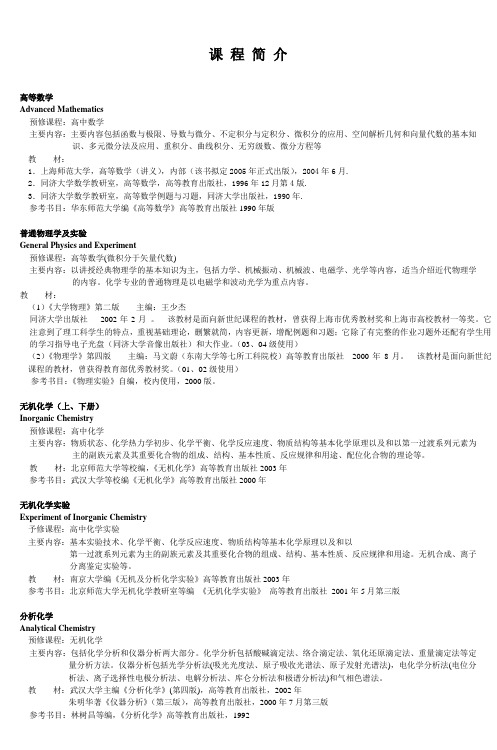无机化学双语教学参考资料(下册)英文版
- 格式:docx
- 大小:365.35 KB
- 文档页数:51


课程简介高等数学Advanced Mathematics预修课程:高中数学主要内容:主要内容包括函数与极限、导数与微分、不定积分与定积分、微积分的应用、空间解析几何和向量代数的基本知识、多元微分法及应用、重积分、曲线积分、无穷级数、微分方程等教材:1.上海师范大学,高等数学(讲义),内部(该书拟定2005年正式出版),2004年6月.2.同济大学数学教研室,高等数学,高等教育出版社,1996年12月第4版.3.同济大学数学教研室,高等数学例题与习题,同济大学出版社,1990年.参考书目:华东师范大学编《高等数学》高等教育出版社1990年版普通物理学及实验General Physics and Experiment预修课程:高等数学(微积分于矢量代数)主要内容:以讲授经典物理学的基本知识为主,包括力学、机械振动、机械波、电磁学、光学等内容,适当介绍近代物理学的内容。
化学专业的普通物理是以电磁学和波动光学为重点内容。
教材:(1)《大学物理》第二版主编:王少杰同济大学出版社2002年2月。
该教材是面向新世纪课程的教材,曾获得上海市优秀教材奖和上海市高校教材一等奖。
它注意到了理工科学生的特点,重视基础理论,删繁就简,内容更新,增配例题和习题;它除了有完整的作业习题外还配有学生用的学习指导电子光盘(同济大学音像出版社)和大作业。
(03、04级使用)(2)《物理学》第四版主编:马文蔚(东南大学等七所工科院校)高等教育出版社2000年8月。
该教材是面向新世纪课程的教材,曾获得教育部优秀教材奖。
(01、02级使用)参考书目:《物理实验》自编,校内使用,2000版。
无机化学(上、下册)Inorganic Chemistry预修课程:高中化学主要内容:物质状态、化学热力学初步、化学平衡、化学反应速度、物质结构等基本化学原理以及和以第一过渡系列元素为主的副族元素及其重要化合物的组成、结构、基本性质、反应规律和用途、配位化合物的理论等。

第一章化学反应中的质量关系和能量关系[学习指导]1.“物质的量”(n)用于计量指定的微观基本单元或其特定组合的物理量,其单位名称为摩[尔],单位符号为mol。
2.摩尔质量(M) M = m/n3.摩尔体积(V m)V m = V/n4.物质的量浓度(c B)c B = n B/V5.理想气体状态方程pV = nRT6.理想气体分压定律p= Σp B ;p B = (n B/n)p7.化学计量式和化学计量数O = ΣνB B ;νBB8.反应进度(ξ)表示化学反应进行程度的物理量,符号为ξ,单位为mol。
随着反应的进行,任一化学反应各反应物及产物的改变量:Δn B = νBξ9.状态函数状态函数的改变量只与体系的始、终态有关,而与状态变化的途径无关。
10.热和功体系和环境之间因温差而传递的热量称为热。
除热以外,其它各种形式被传递的能量称为功。
11.热力学能(U)体系内部所含的总能量。
12.能量守恒定律孤立体系中能量是不会自生自灭的,它可以变换形式,但总值不变。
13.热力学第一定律封闭体系热力学能的变化:ΔU = Q + WQ > 0, W > 0, ΔU > 0;Q < 0, W < 0, ΔU < 0。
14.恒压反应热(Q p)和反应焓变(Δr H m)H(焓) ≡U + pV, Q p = Δr H m15.赫斯定律Q p = ∑Q B , Δr H m = ∑Δr H m(B)B B16.标准状况:p = 101.325kPa, T = 273.15 K标准(状)态:pθ= 100kPa下气体:纯气体物质液体、固体:最稳定的纯液体、纯固体物质。
溶液中的溶质:摩尔浓度为1mol·L-1标准态下17.标准摩尔生成焓()最稳定的单质─────—→单位物质的量的某物质=18.标准摩尔反应焓变()一般反应cC + dD = yY + zZ=[y(Y) + z(Z)] - [c(C)+ d(D)]=Σνi(生成物) + Σνi(反应物)第二章化学反应的方向、速率和限度[学习指导]1.反应速率:单位体积内反应进行程度随时间的变化率,即:2.活化分子:具有等于或超过E c能量(分子发生有效碰撞所必须具备的最低能量)的分子。

习题集(Collection of Questions)Chapter 1 –Introduction to Polymeric Materials1. Many polymers occur in nature. Name any two naturally occurring polymers.2. What will happen when we begin heating each of the polymers below?a) A thermosetting (polymer).b) A thermoplastic (polymer).3. Name any two properties that you may look for in describing a polymer.4. Describe what is meant by the term "polymer".5. Briefly explain the difference in molecular chemistry between silicone polymer and other polymeric materials.Chapter 2—Plastics1. What is metallocene PE? And what are the differences among metallocene PE, HDPE and LLDPE?2. How many types of conformations do the polypropylene have?3. What are the main properties of PS? When compared with PS, what advantage does ABS have?4. Define Polyvinyls, PS, PP, HDPE, chemical structure.5. Compare the density PVC, PVB, PS, and PVDC which is higher/lower than PP.6. Compare the density of HDPE, LDPE, UHMWPE, LLDPE to PP?7. What is the tensile strength of PP with 0%, 30% glass fibers? What is the tensile modulus?8. Plot tensile strength and tensile modulus of PVC, PS, PP, LDPE and HPDE to look like:9. Which of the following are thermoplastics: hard rubber, Bakelite, PVC, polystyrene, polyethylene?10. Which of the following are thermoset plastics: Melamine dishware, Bakelite, hard rubber?11. What is the principal structural difference between LDPE and HDPE?12. Which has the higher value for a specific polymer with both amorphous and crystalline regions: Tg or Tm?13. Which is the faster reaction: step reaction or chain reaction polymerization? 14. Write down the formulations of epoxy resin.TensileStrength,KpsiTensile Modulus, Kpsi105015.List the main applications of epoxy plastics.16.What are the main processing methods of thermosetting plastics?pared with thermoplastics, what are the advantage and disadvantage ofthermosetting plastics?18.What are meant by A-stage and B-stage phenolics?19.What are the characteristics and application categories of amino plastics20.List the main applications of unsaturated polyester.21.List the properties of glass fiber (GF) reinforced unsaturated polyester and GFreinforced epoxy plastics.22.Write down the chemical structure of PET?23.What are the structure characteristics of PTFE? Why it has good auto-lubricatingproperty?24.What are the main characteristics of Nylon families.pare the properties of Nylon with POM, and find out their potentialapplication fields.26.Why does PPS show an excellent heat resistance?27.List the main applications of PPS.Chapter 3 Elastomers一、简述题1.Briefly explain the mechanism of elasticity of rubbers?pare the structural difference between natural rubber and syntheticpolyisoprene. the most important three commercial rubbers and explain why?4.Give three examples of the application of rubber in industry.pare the structure and properties between SBR and SBS.6.What are specialized rubbers? Explain the structure-properties relationship.7.Give the advantages and disadvantages of thermoplastic rubbers.8.How to choose a rubber according to given requirements.9.Explain the function of all kind of additives in rubber, and name at least fourcommon additives.10.Please give the typical procedure of preparing sulphur vulcanized rubbers.11. 聚乙烯和聚丙烯为通用塑料,但它们的共聚物却可以成为橡胶,为什么?12. 举例说明热塑性弹性体的弹性原理。

绪论1一、无机化学的研究对象1二、无机化学学科的动向和趋势1三、无机化学在国民经济及日常生活中的作用3四、无机化学的任务和学习方法3 第一章原子结构与周期律4第一节原子核外电子的运动状态4一、核外电子的运动特点4二、核外电子运动状态的近代描述5三、四个量子数5第二节基态原子核外电子的排布7一、多电子原子轨道的能级7二、核外电子排布规律8第三节原子结构与元素周期律10一、周期与能级组10二、族与电子构型11 三、元素分区11第四节元素性质的周期性12一、有效核电荷12二、原子半径12三、电离能13四、电子亲和能14五、电负性14知识拓展氟里昂的发现与元素周期表16习题16第二章分子结构与晶体结构19第一节离子键理论19一、离子键理论的要点19二、离子的特征20第二节共价键理论21一、H2分子中的化学键21二、价键理论的要点21第三节杂化轨道理论简介24一、杂化轨道理论的基本要点24二、杂化方式与分子的空间构型25三、等性杂化与不等性杂化26四、金属键26第四节分子间作用力27一、分子的极性27二、分子间作用力27三、氢键29第五节晶体结构30一、晶体的基本知识30二、晶体的基本类型与性质30知识拓展二氧化碳能转变为汽油吗?31习题32第三章化学反应速率和化学平衡34第一节化学热力学基本知识34一、基本概念34二、化学反应热效应35三、热化学方程式36第二节化学反应速率36一、化学反应速率36二、反应速率理论简介37 第三节影响反应速率的因素39一、浓度对化学反应速率的影响39二、温度对化学反应速率的影响40三、催化剂对化学反应速率的影响41四、影响多相反应速率的因素43第三节化学平衡43一、化学平衡43二、标准平衡常数44三、多重平衡规则45第四节化学平衡的移动46一、浓度对化学平衡的影响46二、压力对化学平衡的影响47三、温度对化学平衡的影响47四、催化剂与化学平衡48五、勒·夏特列原理48六、反应速率与化学平衡的应用48 知识拓展新能源48习题49第四章酸碱平衡52第一节溶液的基本知识52一、溶液的浓度的表示方法52二、有关物质的量浓度的计算53三、稀溶液的性质53第二节酸碱理论55一、酸碱的解离理论55二、酸碱的质子理论55三、酸碱的电子理论56第三节溶液的酸碱性56一、水的解离平衡56二、溶液的pH57三、酸碱指示剂57第四节弱酸、弱碱的解离平衡58一、一元弱酸、弱碱的解离平衡58二、多元弱酸的解离平衡60三、同离子效应和盐效应60第五节缓冲溶液61一、缓冲溶液及缓冲作用原理61二、缓冲溶液的pH62三、缓冲溶液的应用63第六节酸碱滴定法简介63知识拓展酸碱食品与健康64习题65 第五章沉淀溶解平衡68 第一节沉淀溶解平衡68一、沉淀溶解平衡与溶度积常数68二、溶度积与溶解度68第二节沉淀的生成与溶解69一、溶度积规则69二、沉淀的生成70三、沉淀的溶解72第三节沉淀滴定法74一、方法简介74二、银量法确定理论终点的方法74 知识拓展免疫共沉淀技术75习题76第六章氧化还原平衡78第一节氧化还原反应的基本概念78一、元素的氧化数78二、氧化还原电对79三、氧化还原反应方程式的配平79 第二节原电池与电极电势81一、原电池的组成81二、原电池的电动势82三、标准电极电势82四、影响电极电势的因素84第三节电极电势的应用86一、判断氧化剂和还原剂的相对强弱86二、氧化还原反应可能进行的方向和次序86三、判断氧化还原反应进行的程度87四、元素电势图及其应用88第四节氧化还原滴定法简介89一、特点89二、高锰酸钾标准溶液90三、实例——Ca2+的测定(间接滴定法)90第五节实用电化学91一、金属的腐蚀91二、防止金属腐蚀的方法92知识拓展新型燃料电池92习题93第七章配位平衡96第一节配位化合物的基本概念96一、配合物的定义96二、配合物的组成96三、配合物的命名97四、螯合物98第二节配位化合物的结构99一、配位化合物价键理论的基本要点99二、配位化合物空间构型99第三节配位平衡100一、配合物的稳定常数100二、配位平衡的移动101第四节配位化合物的应用103一、分析化学研究方面103二、生物化学方面103三、工业生产方面103第五节配位滴定法简介103一、金属指示剂的作用原理103二、配位滴定方式及其应用104知识拓展螯合纤维105习题106第八章重要的非金属元素108第一节卤素108一、卤素单质108二、氢卤酸和卤化物110三、氯的含氧酸及其盐111四、卤素离子的鉴定113第二节氧族元素113一、臭氧114二、过氧化氢114三、氢硫酸与硫化物115四、硫酸及硫酸盐116第三节氮族元素117一、氨与铵盐118二、磷酸与磷酸盐119三、砷的重要化合物120第四节碳族元素122一、碳的重要化合物122二、硅的重要化合物124知识拓展新型陶瓷材料——碳化硅125习题126第九章重要的金属元素128 第一节铝及其化合物128一、单质铝的性质128二、氧化铝和氢氧化铝129第二节锡、铅及其化合物130一、锡的重要化合物130二、铅的重要化合物131三、Sn2+、Pb2+的鉴定131第三节铜、银及其化合物131一、铜及其化合物132二、银及其化合物133第四节锌、镉、汞及其化合物135一、锌及其重要化合物135二、汞及其重要化合物136第五节铬及其化合物138一、铬单质的性质138二、铬的重要化合物138第六节锰及其重要化合物140一、锰的重要化合物140二、Mn2+、MnO-4的鉴定141第七节铁及其重要化合物141一、铁单质的性质141二、铁的重要化合物142三、Fe2+和Fe3+的鉴定144知识拓展金属与生活——稀土金属的应用144习题145第十章绿色化学概述147一、绿色化学的定义与原则147二、绿色化学的研究内容148三、绿色化学与可持续发展148四、绿色化学技术148五、绿色化学与化工的发展趋势150 第十一章无机材料152第一节重要金属及合金材料152一、碳素钢及合金钢152二、有色金属与合金153第二节无机非金属材料154一、传统陶瓷154二、新型陶瓷154 第三节几种无机功能材料155一、磁性材料155二、超导材料155三、光导纤维与激光材料156四、纳米材料156第十二章无机化学基础实验157【项目1】无机化学实验基本操作157 【项目2】试管操作162【项目3】液体量具的使用162【项目4】溶液的配制164【项目5】重要的非金属元素的性质164【项目6】重要的金属元素的性质167 【项目7】常见阴、阳离子的定性检验169第十三章无机化学综合实验177【项目1】氯化钠的提纯177【项目2】硫酸铜的提纯178【项目3】硫酸亚铁铵的制备180【项目4】明矾的制备182 【项目5】氯化铵的制备183第十四章设计与创新性实验186【项目1】甲酸铜的制备186【项目2】三草酸合铁(Ⅲ)酸钾的制备186【项目3】茶叶中一些元素的分离与鉴定187附录189附录一酸、碱的标准解离常数189 附录二溶度积常数 附录三标准电极电势附录四配离子的稳定常数附录五常见酸、碱水溶液的相对密度与其质量分数196当我被上帝造出来时,上帝问我想在人间当一个怎样的人,我不假思索的说,我要做一个伟大的世人皆知的人。

所有化学专业的电子书1、高等物理化学.pdf2、高等学校教材物理化学(第四版)上册.pdf3、物理化学(第二版)(上册).djvu4、物理化学(第二版)下册.djvu5、物理化学_上册.pdf6、物理化学_中册.pdf7、物理化学_下册.pdf8、物理化学习题大连理工.pdf9、物理化学习题大连理工.pdf10、物理化学习题详解.pdf11、物理化学习题.pdf12、物理化学实验武汉大学.pdf13、物理化学实验.pdf14、物理化学实验崔献英.pdf15、物理化学.pdf16、物理化学例题与习题.pdf17、物理化学简明教程薛万华.pdf18、物理化学王光信.pdf19、基础物理化学(下册)湖南大学.pdf20、计算物理化学.pdf21、Physical Chemistry_ Third Edition.pdf分析化学1、原子荧光谱分析.pdf2、电分析化学.蒲国刚袁倬斌吴守国.pdf3、分析化学手册(第二版)第二分册_化学分析.pdf4、分析化学手册(第二版)第四分册_电化学分析.pdf5、分析化学手册(第二版)第一分册_基础知识与安全知识.pdf6、分析化学丛书-第三卷-第三册-高效液相色谱法-邹汉法-张玉奎-卢佩章.pdf7、分子发光分析法(荧光法和磷光法)_彭采尔等.pdf8、核磁共振基础简论.pdf9、分析化学武汉3版.pdf10、激光光谱分析法.pdf11、实用荧光分析法_夏锦尧.pdf12、原子荧光光谱学.pdf13、分析化学武汉3版.pdf14、分析化学(张正奇).pdf15、分析化学(钟佩珩).pdf16、共振荧光与超荧光.pdf17、小波变换及其在分析化学中的应用.pdf18、分析化学北大.pdf19、分析化学与水质分析.pdf20、分析化学习题精解.pdf21、分析化学武汉大学第四版.pdf22、分析化学手册-质谱分析.pdf23、分析化学手册-液相色谱分析.pdf24、EAIH.rar25、分析化学钟佩衍.pdf26、分析化学湖南大学.pdf27、Elemental Speciation (Comprehensive Analytical Chemistry) Vol 33.rar 有机化学1、磁性体手册_近角聪信.pdf2、波谱数据表:有机化合物的结构解析.rar3、Schaums题解精萃有机化学英文.rar4、茶多酚化学.pdf5、茶多酚化学_11246278.rar6、芳烃化学与芳烃生产.pdf7、催化氢化在有机合成中的应用_10308695.rar8、高等学校教材高等有机化学_11270168.rar9、高等学校教学参考书有机硅化学.rar10、高等学校教材高等有机合成_11348653.rar11、高等有机化学.rar12、工业精细有机合成原理_10149380.rar13、固相有机合成:原理及应用指南_11308745.rar14、工业有机合成基础_10149340.rar15、哈佛大学有机化学.rar16、含氮有机化合物概论.rar17、合成有机化学中的氢化与氢解.rar18、环糊精化学——基础与应用_10346785.rar19、金属参与的现代有机合成反应.rar20、金属有机化合物的反应化学.rar21、金属有机化合物在有机合成中的应用.rar22、精编有机化学教程_11221085.rar23、曼尼希反应和曼尼希碱化学.pdf24、基础有机化学习题解答与解题示例_邢其毅等_.pdf25、莫里森有机化学.part1.rar26、莫里森有机化学.part2.rar27、莫里森有机化学.part3.rar28、手性合成——不对称反应及其应用.rar29、四唑化学的现代理论.rar30、无溶剂有机合成_11353375.rar31、现代有机合成化学 -- 选择性有机合成.pdf32、手性合成_11433704.rar33、现代有机合成化学——选择性有机合成反应和复杂有机分子合_10858579.rar34、油脂化学_11211889.rar35、新编有机合成化学_11114001.rar36、有机催化_10309182.rar37、有机电化学合成导论.pdf38、有机电合成进展.rar39、有机反应机理的基本原理.rar40、有机反应中的酸碱催化.rar41、有机分子结构光谱鉴定.rar42、有机硅聚合物导论_10479663.rar43、有机硅高分子化学_10310839.rar44、有机合成切断法探讨.rar45、有机合成(下册)_10190879.rar46、有机合成_11413500.rar47、有机合成的新途径过渡金属之利用.rar48、有机合成第三集.rar49、有机合成化学与路线设计.rar50、有机合成设计.rar51、有机合成事典.part1.rar52、有机合成事典.part2.rar53、有机化合物的光谱鉴定.rar54、有机化合物分子旋光性的螺旋理论.rar55、有机化合物结构鉴定与有机波谱学.pdf56、有机化学_11119037.rar57、有机化学概论和问题解析.rar58、有机化学实验.rar59、有机化学习题精解.rar60、有机化学现代电子理论(通俗解说).rar61、有机化学中的光谱方法.rar62、有机化学中的光谱方法.pdf63、有机化学中的立体电子效应.pdf64、有机化学中的氢键问题_王庆文_.pdf65、有机化学中的取代基效应_11113241.rar66、有机化学中的人名反应.pdf67、有机化学中的溶剂效应_10308692.rar68、有机磷化学研究.pdf69、有机人名反应完整(英文_2B中文译版).rar70、有机物英汉命名构词法.rar71、有机化学中的空间效应.pdf72、有机质谱原理.rar73、中级有机化学_11251430.rar74、重要有机化学反应(第二版).pdf75、元素有机化学.rar76、杂环人名反应.part3.rar77、高等有机化学反应、机理和结构下册.rar78、有机化学实验(清华版).pdf79、高等有机化学(汪秋安).pdf80、基础有机化学(第二版)上、下册_邢其毅等_.pdf81、基础有机化学习题解答与解题示例_邢其毅等_.pdf82、MIT有机结构试卷2份.rar83、Comprehensive Organic Synthesis.iso84、有机化学伍越寰.pdf85、元素的轨迹.pdf86、有机化学习题精解.pdf87、有机化学实验.pdf88、有机化学实验北大.pdf89、有机化学教程.pdf90、有机化学辅导及题解.pdf91、有机化学湖南大学.pdf92、有机化学韦国峰.pdf93、有机化学傅建熙.pdf94、有机合成化学与路线设计.pdf95、有机地球化学研究新进展.pdf96、基础化学2-有机化学司宗兴.pdf97、哈佛高等有机化学1.rar98、哈佛高等有机化学2.rar99、哈佛高等有机化学3.rar100、大学有机化学基础.pdf101、17942Organic.Chemistry.WhatHowWhy.rar102、_化学丛书_.Organic.Chemistry.(Brooks_.5th.Ed_.1999).pdf103、_化学丛书_anic.Chemistry.Reactions_.Mechanisms_.and.Structure.4th.Edition.( Jerry.March).pdf104、_化学丛书_anic.Chemistry.Reactions_.Mechanisms.and.Structure.5th.Edi tion.(Michael.B.Smith._.Jerry.March).pdf105、_化学丛书_.Organic.Chemistry.(Brooks_.5th.Ed_.1999).pdf106、_化学丛书_anic.Chemistry.Reactions_.Mechanisms_.and.Structure.4th.Edition.( Jerry.March).pdf107、_化学丛书_.Organic.Chemistry.(Brooks_.5th.Ed_.1999).pdf无机化学1、01_第一卷.稀有气体、氢、碱金属.pdf2、02_第二卷.铍碱土金属硼铝镓分族.pdf3、03_第三卷.碳硅锗分族.pdf4、04_第四卷.氮磷砷分族.pdf5、05_第五卷.氧硫硒分族.pdf6、06_第六卷.卤素.铜分族.锌分族.pdf7、07_第七卷.钪稀土元素.pdf8、08_第八卷.钛分族钒分族铬分族.pdf9、09_第九卷.锰分族铁系铂系.pdf10、10_第十卷.锕系锕系后元素.pdf11、 11_第十一卷.无机结构化学.pdf12、12_第十二卷.配位化学.pdf13、13_第十三卷.无机物动力学.pdf14、14_第十四卷.无机物相平衡、非整比化合物.pdf15、15_第十五卷.有机金属化合物.生物元机化学.pdf16、16_第十六卷.放射化学.pdf17、17_第十七卷.稳定同位素化学.pdf18、18_第十八卷.地球化学.pdf19、重要无机化学反应(第三版)_陈寿椿.pdf20、高等无机化学-index.pdf21、高等无机化学-text.pdf22、无机化学-mit.rar23、无机氧化物.pdf24、无机化学实验.pdf25、高等无机化学(关鲁雄).pdf26高等无机化学-index.pdf27、高等无机化学-text.pdf28、无机化学(申泮文主编).pdf29、无机及分析化学.pdf30、无机及分析化学张仕勇.pdf31、无机化学习题.pdf32、无机化学例题与习题.pdf33、无机合成及制备化学.pdf34、稳定同位素地球化学.pdf35、微型无机化学实验.pdf36、普通无机化学实验.pdf37、普通无机化学精要与分级训练.pdf生物化学1、生化生产工艺学_10252998.rar2、生物化学_11293373.rar3、生物化学_11074599.rar4、生物活性磷杂环化学.rar5、植物化学-.pdf6、植物生物化学技术与方法.pdf7、植物生物化学.pdf8、植物化学译文集.pdf9、原生动物生物化学.pdf10、植物化学.pdf11、植物化学高锦明.pdf12、医学生物化学.pdf13、糖类生物化学.pdf14、生物有机化学-.pdf15、生物化学与分子生物学实验技术杨安钢.pdf16、生物无机化学原理.pdf17、生物化学译从一.pdf18、生物化学与分子生物学实验技术厉朝龙.pdf19、生物化学与分子生物学高级教程周虹徐文弟.pdf20、生物化学习题集.pdf21、生物化学仪器分析与实验技术周先碗胡小倩.pdf22、生物化学图解.pdf23、生物化学习题.pdf24、生物化学-.pdf25、生物化学实验技术.pdf26、生物化学实验.pdf27、生物化学周爱儒.pdf28、生物化学简明教程吴相钰.pdf29、生物化学技术原理及其作用.pdf30、生物化学的黄金时代.pdf31、生物化学.pdf32、生物化学(上)沈同.pdf33、生物化学谢诗占.pdf34、生物化学李建武.pdf35、生理学生物化学.pdf36、昆虫生物化学分析法.pdf37、昆虫生物化学-.pdf38、昆虫生物化学.pdf39、昆虫生理生化学.pdf40、昆虫分析生物化学.pdf41、昆虫毒理学专题.pdf42、中国生物无机化学十年进展.pdf43、高等环境化学与微生物学原理张锡辉.pdf44、肝脏生物化学.pdf药物化学1、最新最权威的药物研发参考书创新药物化学_11370915.part2.rar2、表面活性剂在药学中的应用_10312014.part3.rar3、常用中药化学鉴定_11394846.rar4、表面活性剂在药学中的应用_10312014.part2.rar5、高等学校教材天然药物化学_11283819.rar6、核苷化学合成_11408423.rar7、化学和化工与制药.pdf8、化学制药工艺学_10419872.rar9、化学制药专业高级技术培训教材制药化工过程及设备_10149277.rar10、合成药物与中间体手册_11188079.rar11、精细化学品大全•农药卷.pdf12、生物利用度控制:药物化学原理、方法和应用_11370538.rar13、精细化工产品手册药物_10959619.rar14、世界手性药物选集_10232804.rar15、手性药物的化学与生物学.rar16、世界有机药物专利制备方法大全第一卷_10149294.rar17、天然药物化学实验与指导_11226600.rar18、新编药物合成手册(上卷)_11129084.rar19、新编药物合成手册(上、下卷朱宝泉2002年版).part1.rar20、新编药物合成手册(上、下卷朱宝泉2002年版).part2.rar21、新杂环农药的研究发展及合成方法_11276079.rar22、天然药物化学(供药学类专业用)_11259273.rar23、药物合成反应:第二版_11113977.rar24、药物合成反应.pdf25、药物合成反应_10034192.rar26、药物化学_11353678.rar27、药物化学学习指导供药学类专业用_11297335.rar28、药物化学总论_11250506.rar29、药物化学_11196811.rar30、药物中间体合成工艺_10423712.rar31、药物制造技术_10309038.rar32、医药化学影印本_11085277.rar33、医药中间体手册(下册)_11129010.rar34、医药中间体手册(上册)_10328345.rar35、制药工程_10507162.rar36、制药工艺学_11142765.rar37、最新最权威的药物研发参考书创新药物化学_11370915.part1.rar高分子化学1、合成树脂饰面人造板_11208154.rar2、耐高温聚合物及其复合材料合成、应用与发展_11349956.rar3、高等学校教材聚合物合成工艺设计_11344441.rar4、高聚物的表面与界面_10193123.rar5、合成聚合物乳液的应用第三卷聚合物乳液的其他应用_11301469.rar6、合成聚合物乳液的应用涂料中的乳液:乳胶漆第二卷_11290134.rar7、聚合物X射线衍射_10310945.rar8、聚合物材料用化学助剂_11123601.rar9、聚合物化学_10943137.rar10、聚合物化学导论_10073411.rar11、聚合物化学中的反应活性、机理和结构_10310879.rar12、聚合物科学与工程学基本原理_10201715.rar13、聚合物粘弹性引论_10310913.rar14、聚合反应原理_10310825.rar15、高等学校教材高分子合成材料学上册_11429580.rar16、高等学校教材高分子化学习题及解答_11302477.rar17、高等学校教材高分子科学与工程系列教材高分子物理_11370698.rar18、高等学校教学用书高分子物化学原理_10184080.rar19、现代高分子物理学(上册)_10311349.rar20、高分子材料专业双语教材聚合物化学_11412087.rar21、高分子X射线学_11129271.rar22、高分子光化学导论:基础和应用_11188148.rar23、高分子合成反应_10310844.rar24、高分子合成新技术_11281359.rar25、高分子合成原理及工艺学_10538894.rar26、高分子化学_10176364.rar27、高分子化学_10193142.rar28、高分子辞典_10176381.rar29、高分子化学_11301537.rar30、高分子化学和物理_11164215.rar31、高分子化学基础(上册)_10257322.rar32、高分子化学基础(中册)_10257323.rar33、高分子化学基础(下册)_10257324.rar34、高分子化学实验_11114683.rar36、高分子结构研究中的光谱方法_10193125.rar37、高分子界面科学_10310898.rar38、高分子科学基础_11142754.rar39、高分子科学实验_10193138.rar40、高分子科学与材料基础_10190889.rar41、高分子设计的数学模拟_10310341.rar42、高分子化学_10310895.rar43、高分子实验与专论.pdf44、高分子物理_10073499.rar45、高分子物理_10497718.rar46、高分子实验技术(修订版).pdf47、高分子物理实验.pdf48、高分子物理学中的标度概念_10919021.rar49、功能高分子与新技术_10900708.rar50、高分子物理_11395234.rar51、跨世纪的高分子科学高分子化学_10655760.rar52、南京大学教材出版资助项目高分子物理实验_10112274.rar53、普通高等教育“九五”国家级重点教材高分子物理(第二_10190680.rar54、生物高分子第9卷生物高分子的多样性与合成高分子_11359940.rar55、微型高分子化学实验技术.pdf56、天然高分子化学_10310352.rar57、高分子化学周其凤.pdf58、高分子化学张兴英.pdf59、高分子辐射化学张志成.pdf(注:文档可能无法思考全面,请浏览后下载,供参考。
1 无机化学双语教学 参考资料(下册) 2
Chapter One Nitrogen Family (Group Ⅴ) Central contents: 1. Know the general properties of elements of the nitrogen group and inert electron pair effect 2. Know the reactions of ammonia, understand the thermal decomposition trend of ammonium salts 3. Know the properties of nitrous acid and nitrites; understand the structure of nitric acid and nitrate radical; understand the thermal decomposition trend of nitrates 4. Know well the properties of phosphoric acid and phosphates 5. Know the properties of oxides of As, Sb, Bi and their hydrates; understand the properties of sulfides of As, Sb, Bi; know the trends of these compounds 6. Understand the properties of the salts of As, Sb, Bi 7. Understand the identification methods for NH4+, NO2-, NO3-, PO43- and Bi3+ 3
Section One The General Properties of Elements of the Nitrogen Group 1. Know the following: 1) Valence shell configuration ns2np3 2) Nonmetal → metalloid → metal 3) Oxidation number: 0、+3、+5 4) Bonding character
2. Inert electron pair effect: In the same group, the stability will increase from up to down when the elements have lower oxidation number; but the stability will decrease from up to down when the elements have higher oxidation number 4
Section Two Nitrogen and Its main Compounds 1.The properties of ammonia and ammonium salts 1) Physical properties of ammonia: (1) Ammonia is a colorless gas with an exceedingly pungent ordor (2) Readily soluble in the water, one volume H2O can dissolve seven hundred volumes NH3 (15mol·L-1) (3) It condenses to a liquid at -33℃ at ambient pressure (25℃/9.9 atm) (4) When liquid ammonia becomes gas, it will absorb a great deal of heat, so we can use it as a refrigeration reagent (5) Liquid ammonia is in some ways similar to liquid water. Salts dissolve in ammonia to form conducting solutions, but solubilities are usually lower in ammonia than in water. Alkali metals dissolve in liquid ammonia, and the solution is called liquid ammonia solution 2) Chemical properties of ammonia: (1)Addition reaction: H+, Mn+, molecules NH3 + H+ → NH4+ 4NH3 + Cu2+ → [Cu(NH3)4]2+ 2NH3 + Ag+ → [Ag(NH3)2] + 8NH3 + CaCl2 →CaCl2∙8NH3 (2) Substitution reaction: One hydrogen atom is replaced: NaNH2; two hydrogen atoms are replaced: Ag2NH; three hydrogen atoms are replaced: Li3N (3) Oxidation reaction: O2, MxOy, X2
4NH3 + 3O2 C0400 2N2↑ + 6H2O 4NH3 + 5O2 RhPtC0800 4NO↑ + 6H2O 2NH3+3CuO 3Cu +N2↑ +3H2O 2NH3 + 3Cl2 → N2↑ + 6HCl
3) The properties of ammonium salts Ions NH4+ K+ Rb+ Na+ r+/pm 143 133 148 95 5
a) Ammonium salts of non-oxidative volatile acidNH3↑+ corresponding acid↑
NH4Cl NH3↑ + HCl↑
NH4HCO3 NH3↑ + CO2↑ + H2O b) Ammonium salts of non-oxidative involatile acidNH3↑+acid or acid ammonium salt
(NH4)3PO4 3NH3↑ + H3PO4 (NH4)2SO4 NH3↑ + NH4HSO4 c) Ammonium salts of oxidative acid N2↑+ H2O or N2O↑+ H2O N2O: laughing gas
(NH4)2Cr2O7 N2↑ + Cr2O3 + 4H2O NH4NO2 N2↑+ 2H2O NH4NO3 Cabout0210 N2O↑+ 2H2O 2NH4NO3 C0300 2N2↑ + O2↑ + 4H2O d) Identification of NH4+
○1 NH4+ + OH- H2O +NH3↑ ○2NH4++Nessler’s reagent red-brown↓
2.The properties of nitrous acid and nitrites: 1)HNO2 is a weak acid, Kaθ=7.2×10-4 2) The pure acid is unknown, even aqueous solutions of nitrous acid are unstable, decomposing when heated according to the reaction: NO2-+H+→HNO2→N2O3(blue)+H2O NO↑+NO2↑
3) Most nitrites are soluble in water except AgNO2, and are poisonous and carcinogenic 4) Oxidizing-reducing properties EAθ : NO3- 0.94 HNO2 0.996 NO EBθ: NO3- 0.01 NO2- -0.46 NO 6
So in acid medium, we will mainly use HNO2 as an oxidant, but in base medium, HNO2 will be used as a reductant NO2-+Fe2++2H+→NO↑+Fe3++H2O 2NO2-+2I-+4H+→2NO↑+I2+2H2O 5NO2-+2MnO4-+6H+→5NO3-+2Mn2++3H2O 3.The properties of nitric acid and nitrates 1) The structure of nitric acid
2) The structure of NO3- 3) The properties of HNO3
○1 Pure HNO3 is a colorless liquid, can mix with water in any proportion
○2HNO3 is a strong monoacid and volatile
○34HNO3 lightor 4NO2↑ + O2↑ + 2H2O
○4 HNO3 is a strong oxidant
A) HNO3 reacts with nonmetals 3C+4HNO3(dilute)→3CO2↑+2H2O+4NO↑
C+4HNO3(strong)→CO2↑+2H2O+4NO2↑
S→H2SO4, P→H3PO4, I2→HIO3
B) HNO3 reacts with metals; the products will be decided by the concentration of HNO3 and the